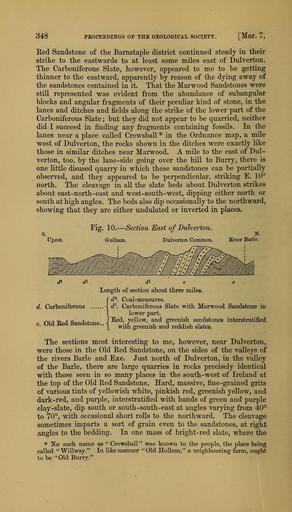MAKE A MEME
View Large Image

| View Original: | The_Quarterly_journal_of_the_Geological_Society_of_London_(13935497381).jpg (1170x2049) | |||
| Download: | Original | Medium | Small | Thumb |
| Courtesy of: | commons.wikimedia.org | More Like This | ||
| Keywords: The Quarterly journal of the Geological Society of London (13935497381).jpg 348 <br> PROCEEDINGS OP THE GEOLOGICAL SOCIETY <br> Mar 7 <br> Bed Sandstone of the Barnstaple district continued steady in their <br> strike to the eastwards to at least some miles east of Dulverton <br> The Carboniferous Slate however appeared to me to be getting <br> thinner to the eastward apparently by reason of the dying away of <br> the sandstones contained in it That the Marwood Sandstones were <br> still represented was evident from the abundance of subangular <br> blocks and angular fragments of their peculiar kind of stone in the <br> lanes and ditches and fields along the strike of the lower part of the <br> Carboniferous Slate ; but they did not appear to be quarried neither <br> did I succeed in finding any fragments containing fossils In the <br> lanes near a place called Crewsball in the Ordnance map a mile <br> west of Dulverton the rocks shown in the ditches were exactly like <br> those in similar ditches near Marwood A mile to the east of Dul- <br> verton too by the lane-side going over the hill to Burry there is <br> one little disused quarry in which these sandstones can be partially <br> observed and they appeared to be perpendicular striking E 10° <br> north The cleavage in all the slate beds about Dulverton strikes <br> about east-north-east and west-south-west dipping either north or <br> south at high angles The beds also dip occasionally to the northward <br> showing that they are either undulated or inverted in places <br> Pig 10 ” Section East of Dulverton <br> Upcot <br> Gulham <br> Dulverton Common <br> Length of section about three miles <br> fd Coal-measures <br> d Carboniferous Slate with Marwood Sandstone in <br> lower part <br> /-Mj -o JO A i- fRed yellow and greenish sandstones interstratified <br> c Old Red Sandstone j <br> The sections most interesting to me however near Dulverton <br> were those in the Old Red Sandstone on the sides of the vaUejs of <br> the rivers Barle and Exe Just north of Dulverton in the valley <br> of the Barle there are large quarries in rocks precisely identical <br> with those seen in so many places in the south-west of Ireland at <br> the top of the Old Red Sandstone Hard massive fine-grained grits <br> of various tints of yellowish white pinkish red greenish yellow and <br> dark-red and purple interstratified with bands of green and purple <br> clay-slate dip south or south- south- east at angles varying from 40° <br> to 70° with occasional short roUs to the northward The cleavage <br> sometimes imparts a sort of grain even to the sandstones at right <br> angles to the bedding In one mass of bright-red slate where the <br> No such name as Crewsball was known to the people the place being <br> called Willway In like manner Old HoUom a neighbouring farm ought <br> to be Old Burry 36164789 111477 51125 Page 348 Text v 22 http //www biodiversitylibrary org/page/36164789 1866 Geological Society of London Biodiversity Heritage Library The Quarterly journal of the Geological Society of London v 22 1866 Geology Periodicals Smithsonian Libraries bhl page 36164789 dc identifier http //biodiversitylibrary org/page/36164789 smithsonian libraries Information field Flickr posted date ISOdate 2014-04-21 Check categories 2015 August 26 CC-BY-2 0 BioDivLibrary https //flickr com/photos/61021753 N02/13935497381 2015-08-26 06 51 42 cc-by-2 0 PD-old-70-1923 The Quarterly journal of the Geological Society of London 1866 Photos uploaded from Flickr by Fæ using a script | ||||